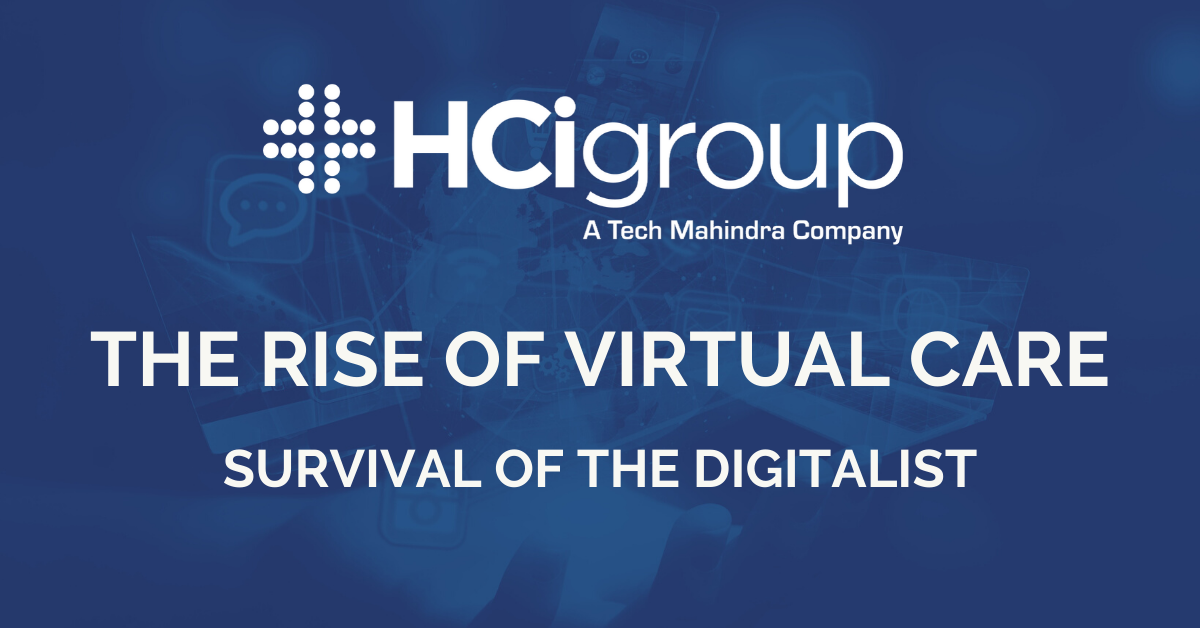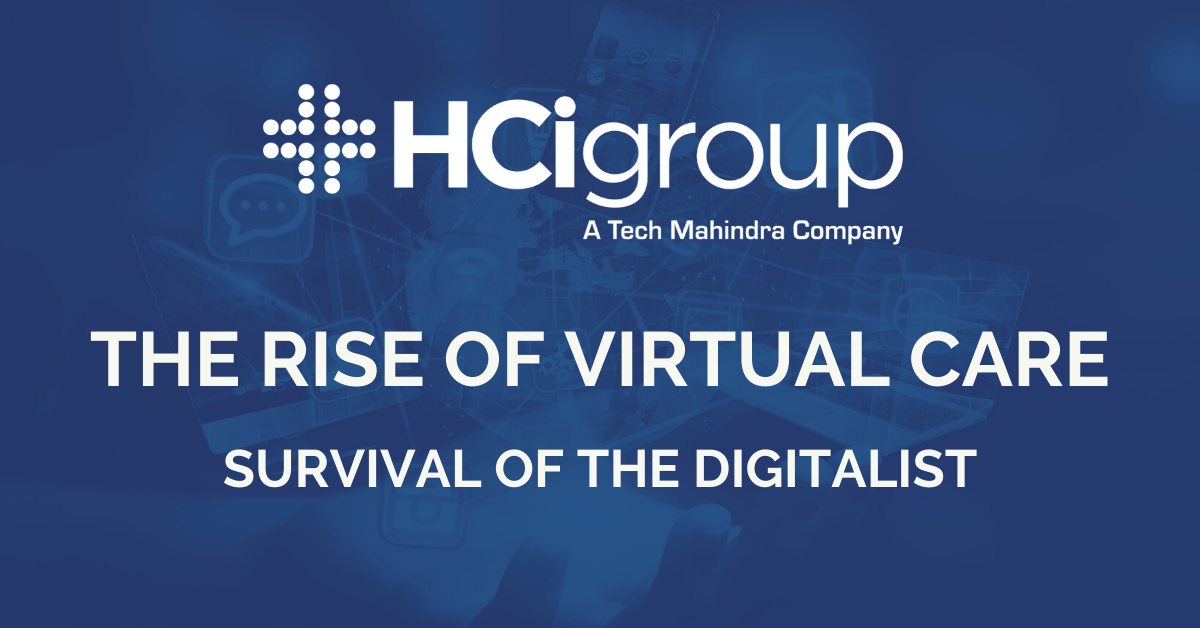The Rise of Virtual Care - Survival of the Digitalist

 In today’s post, the HCI Group’s Chief Digital Officer Ed Marx and Chief Medical Officer (CMO), Dr. Matt Lambert, give their thoughts on the evolution of virtual care, and give some insight into what they believe will be the next great advance in virtual care technology: HealthNxt, the world's first enterprise-class virtual care platform. Designed around human-centric design principles, HealthNxt is a single platform that brings features of best-in-class niche virtual care applications into one seamless offering.
In today’s post, the HCI Group’s Chief Digital Officer Ed Marx and Chief Medical Officer (CMO), Dr. Matt Lambert, give their thoughts on the evolution of virtual care, and give some insight into what they believe will be the next great advance in virtual care technology: HealthNxt, the world's first enterprise-class virtual care platform. Designed around human-centric design principles, HealthNxt is a single platform that brings features of best-in-class niche virtual care applications into one seamless offering.
The Evolution and Challenges of Virtual Care
Over the past several years, the adoption of virtual care has been limited to the retail space and used primarily for episodic care—things such as prescription refills for medications and durable medical equipment. Now, in the span of a few months, telehealth and virtual care have become critical to day-to-day operations of the world’s largest health systems. A recent study published in the Journal of American Informatics Association noted that urgent virtual care visits at NYU’s Langone Health, a prominent New York City hospital, grew by over 600 percent between March 2nd and April 14 of 2020. Furthermore, it was noted that non-urgent virtual visits ballooned by a staggering 4,345 percent during that same timeframe.
According to Dr. Matt Lambert, the Covid-19 pandemic has made virtual care a 'must-have' in these unprecedented times. “After this crisis is over, there will be a new cohort of patients who will expect to receive care this way [through tele-health visits and virtual encounters].”
Right now, according to Dr. Lambert, one of the main challenges faced today is that the virtual care sector is fragmented. In response to Covid-19, health systems have hastily erected a patchwork infrastructure to support the increased demand for virtual care. This infrastructure is often fragmented into multiple (and sometimes redundant) portals and applications that provide virtual care services to patients. “The current state that CMS adopted to respond to [the Covid-19] crisis is you can do telehealth on any device [or platform]. So right now, Microsoft® Teams® is an approved platform, FaceTime® is an approved platform…”
This is not dissimilar to the early years of Electronic Medical Record (EMR) platforms says Ed Marx. “EMRs, in the early days, were siloed, and there was no platform to maintain them. Over the years, kluge interfaces were built, but rich enterprise applications were favored over higher quality applications that were siloed and had limited functionality. Using a single infrastructure came along with multiple benefits—automatic integration, improved security management, standardized hardware, and need to train only one system. Above all, you reduced the complexity of managing five to 10 disparate applications into one.”
The other challenge besides silo-ing and technological fragmentation, is the reluctance to fully adopt the virtual model. Digital hospitals are still housed in centralized brick and mortar facilities; digitally enabled clinicians still drive to buildings to use computers.
Both Ed Marx and Matt Lambert understand the adoption challenge well. Ed recalls his own experience with adoption from the provider side of the spectrum while he was CIO at Cleveland Clinic, “As Chief Information Officer (CIO) of several prominent global health systems, I led teams that looked into an enterprise, integrated virtual care platform. Our take-away was that the virtual care market is light years behind.”
Dr. Lambert points that the main challenge is for patients who may not have the same level of training that providers do in newer technologies. Therefore, it is important that any virtual care platform provide seamless integration with legacy tools and easy to use.
“Once we reach a steady state [beyond the Covid-19 crisis], we are going to have to make it as easy for patients to engage in telemedicine as it is to engage in Microsoft® Teams® or Facetime® conversations, as discomfort with technology will continue to be a problem, especially within senior populations that require the most care. In essence, we need to make accessing virtual care as easy as facetiming with your grandkids.”

HealthNxt: The Next Generation of Virtual Care has Arrived
Seeing an opportunity for disruption in the virtual care market, HCI’s parent company, Tech Mahindra sought a fully integrated solution that could provide comprehensive, longitudinal care for patients—managing their care all the way from the hospital to their home.
The result was HealthNxt, the world's first enterprise-class virtual care platform that was developed in collaboration with a diverse cadre of industry experts including clinicians, engineers, designers and digitalists. This collaboration has transformed HealthNxt into a solution that addresses clinician usability and remains technology and peripheral agnostic. Ease of use and human-centric design were a key factor during the inception of the HealthNxt project, says Ed Marx, “Simplicity is the key and our solution is extremely user-friendly. Hard lessons learned from the EHR journey are helping us in making the practice of medicine more accessible.
HealthNxt is designed to be fully integrated into the clinical space and has the capability to function with legacy tools and integrate seamlessly with most EHR platforms. Patients can also leverage the ambient voice capability to enhance their user experience. Early results of HealthNxt in physician practices and hospitals demonstrate lower costs, improved revenues, and increased care quality.
HealthNxt also combines the principles of human-centric design and physical design to produce a line of elegant, as well as efficient medical peripherals to enhance the experience for all stakeholders (or parties). Our set of peripherals will enable 80% of care to be completed remotely.
The HealthNxt architecture is scalable, allowing growing health systems to and add practices and hospitals with ease. HealthNxt is also equipped with population health tools, including social determinants of health, to enable your organization to realize its mission and community goals better.
Additionally, HealthNxt can be integrated with FirstNet[1], whose mission is to deploy, operate, maintain, and improve the first high-speed, nationwide wireless broadband network dedicated to public safety. This reliable, secure, and innovative public safety communications platform will be instrumental in bringing 21st-century tools to public safety agencies, enabling them to gather information swiftly. This will help them in accelerating their decision-making process.
HealthNxt: A Solution for Survival in the Digital Age
As an expert and advocate for digital transformation, Ed Marx sees the future of healthcare as a continuing evolution from brick and mortar to virtual, “We are working to lay the foundation for the increasing reliance on virtual care with HealthNxt. With a technology platform like this, [in the future] hospitals will be reserved for the most acutely ill, with only a few remaining urgent care facilities and skilled nursing centers. Hospital structures will be repurposed for community benefits such as shelters, schools, and meeting places.”
HealthNxt also offers other tantalizing possibilities, such as its potential to help promote an integrated care model for health providers and the patient populations they serve. Matt Lambert says, “This platform is tailor-made for payors and providers who are in shared risk, population health arrangements.” Such agreements have been championed by the Centers for Medicare and Medicaid Services (CMS) as a mechanism for not only promoting accountability for outcomes in high-risk populations, but also provides incentives for systems that provide high quality and cost-effective health solution to their client populations.
Matt Lambert believes that the Covid-19 crisis has hammered home one important tenant for providers in the healthcare space: through crisis comes innovation. “If there is any upside to what we are going through now, it is that we are going to take a big step forward in the way we deliver care.”
Health organizations that are early adopters of virtual care will prosper and continue to innovate—we like to refer to this as “Survival of the Digitalist”.
The digital age of healthcare has finally arrived, and the perfect tool for digital healthcare delivery is finally here with HealthNxt
Ed Marx has spent 30 years as an executive in some of the world’s largest health systems, to include Cleveland Clinic, New York City Health & Hospitals, and Texas Health Resources. He has won numerous awards, including HIMSS/CHIME 2013 CIO of the Year. Becker’s named Ed as the 2015 “Top Healthcare IT Executive” and among the 2016 “17 Most Influential People in Healthcare.” Ed is the author of multiple healthcare books, to include best seller Voices of Innovation and Healthcare Digital Transformation.
Dr. Matt Lambert is the Chief Medical Officer of the HealthNxt project and a practicing clinician with a wide range of experience in care delivery, healthcare technology and policy, change leadership, and process improvement. Formally with Clinovations and the Advisory Board, he has served as CMIO for New York City Health and Hospitals and the University of Washington. He possesses deep knowledge of current healthcare legislation and how it has impacted the current healthcare environment and telemedicine.
